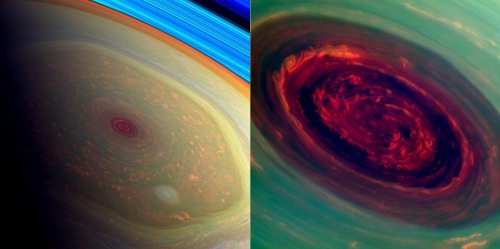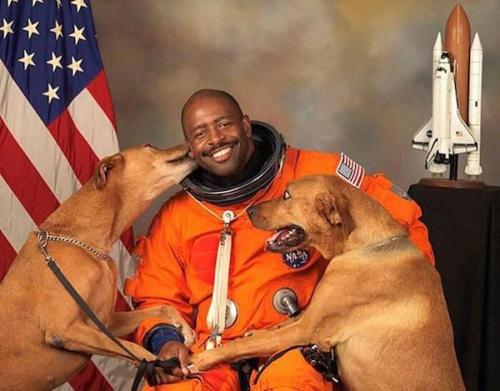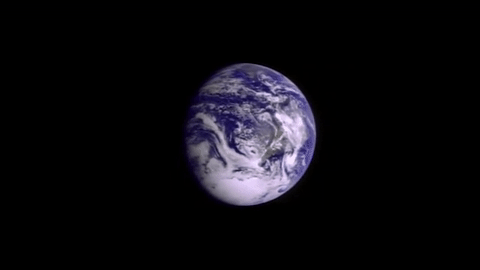Deep Sea Documentaries Have Me Like
deep sea documentaries have me like

More Posts from Intergalacticnerd and Others

how to get an alien to abduct you

Saturn’s hexagonal storm system in it’s north pole

Astronaut Leland Melvin includes his rescued dogs in best NASA portrait ever.
Mars has flowing rivers of briny water, NASA satellite reveals

NASA just released the out-of-this-world news.
7 Facts That Will Make You Feel Very Small

Earth, our home planet, is the fifth largest planet in our solar system and the only planet we know of where life exists. Even though Earth seems extremely large to us, it is actually a tiny spec in the vast expanse of the universe. Here are 7 space facts that will make you feel very small.

1. Our sun is one of at least 100 BILLION stars, just in the Milky Way. Scientists calculate that there are at least 100 billion galaxies in the observable universe, each one brimming with stars. There are more stars than grains of sand on all of Earth’s beaches combined.
In 1995, the first planet beyond our solar system was discovered. Now, thousands of planets orbiting sun-like stars have been discovered, also known as exoplanets.

2. The Milky Way is a huge city of stars, so big that even at the speed of light (which is fast!), it would take 100,000 years to travel across it.

3. Roughly 70% of the universe is made of dark energy. Dark matter makes up about 25%. The rest — everything on Earth, everything ever observed with all of our instruments, all normal matter adds up to less than 5% of the universe.

4. If the sun were as tall as a typical front door, Earth would be the size of a nickel.

5. The sun accounts for almost all of the mass in our solar system. Leaving .2% for all the planets and everything else.

6. Edwin Hubble discovered that the Universe is expanding and that at one point in time (14 billion years ago) the universe was all collected in just one point of space.

7. Four American spacecraft are headed out of our solar system to what scientists call interstellar space. Voyager 1 is the farthest out — more than 11 billion miles from our sun. It was the first manmade object to leave our solar system. Voyager 2, is speeding along at more than 39,000 mph, but will still take more than 296,000 years to pass Sirius, the brightest star in our night sky.
Feeling small yet? Here’s a tool that will show you just how tiny we are compared to everything else out there: http://imagine.gsfc.nasa.gov/features/cosmic/earth.html
Make sure to follow us on Tumblr for your regular dose of space: http://nasa.tumblr.com
Cassini Top 10 Images and Science Results of 2015
As our Cassini spacecraft enters its final 20 months before its plunge into Saturn, the mission’s science team has selected their top 10 images from 2015 (above), a year of historic discoveries, as well as the top science results (below). Take a look:
1. First Deep Seafloor Hydrothermal Vents Found Beyond Earth

Cassini found the first evidence of active hot-water chemistry beyond planet Earth. An extensive, four-year analysis of data from the spacecraft, computer simulations and laboratory experiments led researchers to the conclusion the tiny silica (SiCO2) grains most likely form when hot water containing dissolved minerals from the moon’s rocky interior travels upward, coming into contact with cooler water.
2. Global Ocean Beneath Enceladus’ Surface

A global ocean lies beneath the icy crust of Saturn’s geologically active moon Enceladus. Scientists analyzed more than seven years’ worth of images of Enceladus taken by the spacecraft, which has been orbiting Saturn since mid-2004. As a result, they found Enceladus has a tiny, but measurable wobble as it orbits Saturn. This proves that there must be a global layer of liquid separating the surface from the core.
3. Titan Observed Outside of Saturnian Magnetosphere

During Cassini’s flyby of Titan, the giant moon happened to be on the sunward side of Saturn when a powerful outburst of solar activity reached the planet. The strong surge in the solar wind so compressed the sun-facing side of Saturn’s magnetosphere that the bubble’s outer edge was pushed inside the orbit of Titan. This left the moon exposed to, and unprotected from, the raging stream of energetic solar particles. The region of space dominated by Saturn’s magnetic field is called the magnetosphere.
4. Density of a Ring Particles May Indicate Recent Origins

Saturn’s A ring was found to be warmer than expected at the planet’s equinox, and also had an unusually large thermal asymmetry about the equinox. This could be due to the A ring being mostly composed of denser particles made primarily of solid ice, with a thin top layer of fluffy regolith.
5. Titan Southern Polar Ice Cloud

Scientists have detected a monstrous new cloud of frozen compounds in Titan’s low- to mid-stratosphere – a stable atmospheric region above the troposphere, or active weather layer.
6. Curtain Vents on Enceladus?

New research using data from Cassini suggests most of the eruptions from Saturn’s moon Enceladus might actually be diffuse curtains rather than discrete jets. Many features that appear to be individuals jets of material erupting along the length of prominent “tiger stripe” fractures in the moon’s south polar region might be phantoms created by an optical illusion, according to the new study.
7. Discovery of Tethys Red Arcs

Like graffiti sprayed by an unknown artist, unexplained arc-shaped, reddish streaks are visible on the surface of Saturn’s icy moon Tethys. The origin of the features and their reddish color is a mystery to scientists.
8. Saturn’s 30-year Giant Storms Powered by Water Convection

Changes in temperature and the composition of the hydrogen-laden air within the remnants of a giant storm system on Saturn reveal that air was lofted more than 120 miles in altitude from the deeper water condensation levels.
9. Seasonal Change Seen at Saturn’s Poles

Saturn’s polar regions have displayed extreme seasonal changes during Cassini’s decade-long watch, providing the most comprehensive view ever obtained of seasonal change on a giant planet.
10. Huygens Probe Imaging Mosaic of Titan’s Surface and Descent Movie

Ten years ago, an explorer from Earth, the Huygens probe, was released from the Cassini spacecraft and parachuted into the haze of an alien moon toward an uncertain fate. After a gentle descent lasting more than two hours, it landed with a thud on a frigid floodplain on Titan, surrounded by icy cobblestones.
Make sure to follow us on Tumblr for your regular dose of space: http://nasa.tumblr.com

NASA just released the most detailed photo of space ever taken
The picture of the Andromeda galaxy, the nearest spiral galaxy to our own, is comprised of a mind-boggling 1.5 billion pixels and was snapped from 2.5 million light years away by the powerful Hubble Space Telescope.
See it in all its glory


Thankful for views like this one —————————————– Camera Info •Canon 5D Mk3 •Canon 16-35mm F2.8 •16mm •F2.8 Aperture •30" Exposure •6400 ISO •WB3785 —————————————–#justinhartney #nature #pnwwonderland #nightphotography #ThatPNWLife #Ourlonelyplanet #traveloregon #eugene #universityoforegon #uoregon #feedbacknation #thatNWadventure #wildernessculture #modernoutdoors #watchthisinstagood #folkmagazine #theearthoutdoors #thevisualcollective #oregonexplored #beautifuldestinations #nwc10k #vsco #wishyouwerenorthwest #visitbend #1859Oregon #canon_photos #llbeanmoment #bendmag #optoutside #columbia1938 (at Bend, Oregon)
-
 gamelpar liked this · 1 year ago
gamelpar liked this · 1 year ago -
 enderthefrog liked this · 1 year ago
enderthefrog liked this · 1 year ago -
 thebrofriends liked this · 1 year ago
thebrofriends liked this · 1 year ago -
 birdmanip reblogged this · 1 year ago
birdmanip reblogged this · 1 year ago -
 birdmanip liked this · 1 year ago
birdmanip liked this · 1 year ago -
 local-aquatic-bastard liked this · 1 year ago
local-aquatic-bastard liked this · 1 year ago -
 clousi reblogged this · 1 year ago
clousi reblogged this · 1 year ago -
 iwillhaveamoonbase liked this · 1 year ago
iwillhaveamoonbase liked this · 1 year ago -
 rightventricle liked this · 1 year ago
rightventricle liked this · 1 year ago -
 xoxochrl liked this · 2 years ago
xoxochrl liked this · 2 years ago -
 rumplequeer liked this · 2 years ago
rumplequeer liked this · 2 years ago -
 dreiiton liked this · 2 years ago
dreiiton liked this · 2 years ago -
 nunya32475 liked this · 2 years ago
nunya32475 liked this · 2 years ago -
 helllmouth liked this · 2 years ago
helllmouth liked this · 2 years ago -
 probablyroadkill liked this · 2 years ago
probablyroadkill liked this · 2 years ago -
 insanefastone reblogged this · 2 years ago
insanefastone reblogged this · 2 years ago -
 flying-butter reblogged this · 2 years ago
flying-butter reblogged this · 2 years ago -
 flying-butter liked this · 2 years ago
flying-butter liked this · 2 years ago -
 biblicalhimbos reblogged this · 2 years ago
biblicalhimbos reblogged this · 2 years ago -
 pandanation1989 reblogged this · 2 years ago
pandanation1989 reblogged this · 2 years ago -
 the-starry-seas reblogged this · 2 years ago
the-starry-seas reblogged this · 2 years ago -
 thegoregoblin liked this · 2 years ago
thegoregoblin liked this · 2 years ago -
 mistoffeleesisawitch reblogged this · 2 years ago
mistoffeleesisawitch reblogged this · 2 years ago -
 mistoffeleesisawitch liked this · 2 years ago
mistoffeleesisawitch liked this · 2 years ago -
 its-raining-rats-and-frogs liked this · 2 years ago
its-raining-rats-and-frogs liked this · 2 years ago -
 notafrogblog reblogged this · 2 years ago
notafrogblog reblogged this · 2 years ago -
 underpaidimmortal reblogged this · 2 years ago
underpaidimmortal reblogged this · 2 years ago -
 underpaidimmortal liked this · 2 years ago
underpaidimmortal liked this · 2 years ago -
 luxsolace reblogged this · 2 years ago
luxsolace reblogged this · 2 years ago -
 shrimply-pebbles reblogged this · 2 years ago
shrimply-pebbles reblogged this · 2 years ago
"Astronomy compels the soul to look upwards and leads us from this world to another." - Plato
147 posts